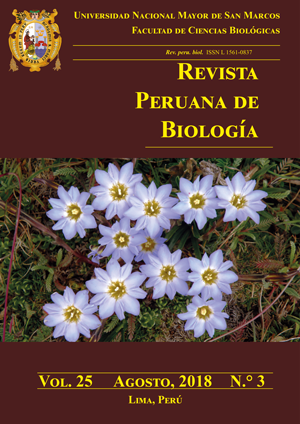Epibiosis in the large marine vertebrates from Mexico: a review and their ecosystemic relevance
DOI:
https://doi.org/10.15381/rpb.v25i3.14786Keywords:
Caribbean manatee, crocodile, marine turtles, symbiosis, whale.Abstract
The aims of this work is review epibiosis reported on the large marine vertebrates from Mexico. The literature review include reporting cases on any of 17 states of the littoral coast of the Mexican Republic, and those published until June 2018. Twenty one papers were found, which report a total of 73 species of flora and fauna superficially associated with eight species of large marine vertebrates: Lepidochelys olivacea, Eretmochelys imbricata, Chelonia mydas, Trichechus manatus manatus, Feresa attenuata, Crocodylus acutus, C. moreletii, Caiman crocodilus chiapasius. The dominant epibiont group was the crustaceans, especially barnacles. The predominant interaction was commensalism, however, parasitic groups were recognized such as the copepods genus Balaenophilus that affects mainly to sea turtles. The relevance of the study of the biofilm, as well as the ecological implications, the presence of new marine species and the conservation of the basibionts species were analyzed to establish criteria that help to understand the importance in marine ecosystems and therefore encourage their study in the region.Downloads
Downloads
Published
Issue
Section
License
Copyright (c) 2018 Marco Violante-Huerta

This work is licensed under a Creative Commons Attribution-NonCommercial-ShareAlike 4.0 International License.
AUTHORS RETAIN THEIR RIGHTS:
a. Authors retain their trade mark rights and patent, and also on any process or procedure described in the article.
b. Authors retain their right to share, copy, distribute, perform and publicly communicate their article (eg, to place their article in an institutional repository or publish it in a book), with an acknowledgment of its initial publication in the Revista Peruana de Biologia.
c. Authors retain theirs right to make a subsequent publication of their work, to use the article or any part thereof (eg a compilation of his papers, lecture notes, thesis, or a book), always indicating its initial publication in the Revista Peruana de Biologia (the originator of the work, journal, volume, number and date).






